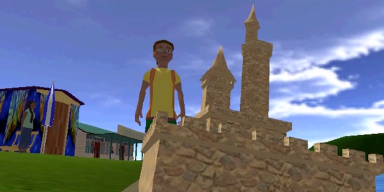Storytelling in any format is about making meaning. While the essence of the stories we tell may remain the same, the ways in which we can now share these stories have changed dramatically with the development of digital communication technologies. Access to simple, easy to use media production tools and resources in conjunction with the potential for immediate and universal online publication has significant implications for literacy thinking and practice.
This website is an evolving compilation of resources designed to support the development of student multimodal authoring at all year levels. It features examples of different types of student multimodal compositions to demonstrate the rich variety of choices available, along with practical resources to support text production.
What does creating multimodal texts mean?
Creating is defined in the Australian Curriculum as ‘the development and/or production of spoken, written or multimodal texts in print or digital forms’ and is an embedded literacy expectation across all disciplines.
Multimodal is defined in the Australian Curriculum as the strategic use of ‘two or more communication modes‘ to make meaning, for example, image, gesture, music, spoken language, and written language.
What is a multimodal text?
While the development of multimodal literacy is strongly associated with the growth of digital communication technologies, multimodal is not synonymous with digital. The choice of media for multimodal text creation is therefore always an important consideration.
A multimodal text can be paper – such as books, comics, posters.
A multimodal text can be digital – from slide presentations, e-books, blogs, e-posters, web pages, and social media, through to animation, film and video games.
A multimodal text can be live – a performance or an event.
And, a multimodal text can be transmedia– where the story is told using ‘multiple delivery channels’ through a combination of media platforms, for example, book, comic, magazine, film, web series, and video game mediums all working as part of the same story. Transmedia is a contested term and Henry Jenkins is worth reading for more background. Jenkins argues that transmedia is more than just multiple media platforms, it is about the logical relations between these media extensions which seek to add something to the story as it moves from one medium to another, not just adaptation or retelling. Transmedia enables the further development of the story world through each new medium; for example offering a back story, a prequel, additional ‘episodes’, or further insight into characters and plot elements. (Jenkins, 2011). It also can require a more complex production process.
Development of multimodal literacy knowledge and skills
To enable our students to effectively design and communicate meaning through such rich and potentially complex texts, we need to extend their (and along the way, our own) multimodal literacy knowledge and skills. Skilled multimodal composition requires new literacy design skills and knowledge to enable students to make informed choices within and across the available communication modes to effectively construct meaning.
Creating a multimodal text, a digital animation, for example, is a complex meaning design process requiring the strategic orchestration of a combination of modes such as image, movement, sound, spatial design, gesture, and language. The process of constructing such texts is also truly a cross-disciplinary literacy process, drawing on digital information technologies and The Arts (media, music, drama, visual arts, design) to bring meaning to life.
About this website
The multimodal text examples here describe different media possibilities – both digital and on paper and provide links to examples of student work and production guides.
Print-based multimodal texts include comics, picture storybooks, graphic novels; and posters, newspapers and brochures.
Digital multimodal texts include slide presentations, animation, book trailers, digital storytelling, live-action filmmaking, music videos, ‘born digital’ storytelling, and various web texts and social media. The level of digital technology requirements range from very simple options such as slide presentations through to complex, sophisticated forms requiring a higher level of technical and digital media skills. The choice is yours depending on your skill and experience, level of confidence, and the resources and tools available to you.
These examples of different types of student multimodal composition are provided as ideas and starting points, and may also provide models for introducing new forms of ‘writing’ to your students.
The technical construction of digital multimodal texts is always a significant consideration for teachers. Practical information about communication technology resources and digital media tools is provided where possible to support the successful implementation of multimodal authoring in the literacy classroom.
Please explore these resources as a starting point to develop ideas to suit your own situation.
How this website works
Practical
Production processes is an overview of the three production stages in creating a multimodal text.
Media resources provides links to a wealth of digital audio and image resources which can be used under creative commons licensing.
Copyright and Attribution provides information about how to ethically source and use digital materials responsibly.
Pedagogy
Modes and meaning systems explores the key meaning-making systems we can use to create meaning
Pedagogy provides a brief guide to teaching creating multimodal texts.
Visual literacy provides a closer look at one of the key meaning-making modes, with the aim to develop a shared metalanguage for talking about how visual meaning is constructed.
Reading multimodal texts provides resources for deconstructing and analysing how different modal systems work to create meaning in a text.

